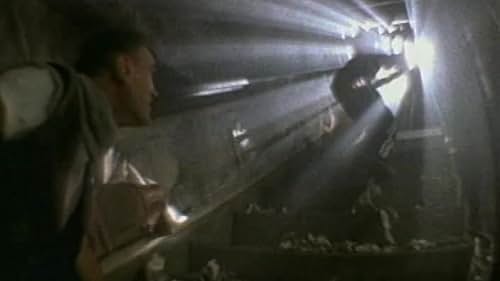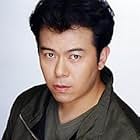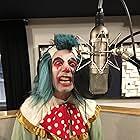VALUTAZIONE IMDb
7,7/10
1652
LA TUA VALUTAZIONE
Aggiungi una trama nella tua linguaSonic and Tails must collect the Chaos Emeralds before Eggman can use them to power an angry water creature known as Chaos. Meanwhile Knuckles attempts to repair the shattered Master Emerald... Leggi tuttoSonic and Tails must collect the Chaos Emeralds before Eggman can use them to power an angry water creature known as Chaos. Meanwhile Knuckles attempts to repair the shattered Master Emerald and Amy must evade capture from an Eggman robot.Sonic and Tails must collect the Chaos Emeralds before Eggman can use them to power an angry water creature known as Chaos. Meanwhile Knuckles attempts to repair the shattered Master Emerald and Amy must evade capture from an Eggman robot.
Jun'ichi Kanemaru
- Sonic the Hedgehog
- (voce)
- (as Junichi Kanemaru)
Nobutoshi Canna
- Knuckles the Echidna
- (voce)
- (as Nobutoshi Hayashi)
Taeko Kawata
- Amy Rose
- (voce)
- (as Taeko Kawada)
Jôji Nakata
- E-102 Gamma
- (voce)
- (as Jyoji Nakata)
Shun Yashiro
- Big the Cat
- (voce)
- (as Syun Yashiro)
Kaho Kôda
- Station Square Announcer
- (voce)
- (as Kaho Kouda)
Tôru Ôkawa
- Pachacamac
- (voce)
Chikao Ôtsuka
- Dr. Ivo 'Eggman' Robotnik
- (voce)
- (as Chikao Ohtsuka)
Ryan Drummond
- Sonic the Hedgehog
- (English version)
- (voce)
Corey Bringas
- Miles 'Tails' Prower
- (English version)
- (voce)
Michael McGaharn
- Knuckles the Echidna
- (English version)
- (voce)
- (as Michael Mcgaharn)
Jennifer Douillard
- Amy Rose
- (English version)
- (voce)
Jon St. John
- Big the Cat
- (English version)
- (voce)
Elara Distler
- Tikal the Echidna
- (English version)
- (voce)
- …
Deem Bristow
- Dr. Ivo 'Eggman' Robotnik
- (English version)
- (voce)
Steve Brodie
- E-102 Gamma
- (English version)
- (voce)
- …
Trama
Lo sapevi?
- QuizMany of the textures used in the game were actually photos taken by Sonic Team on their trip to Central America and South America.
- BlooperStart Super Sonic's quest, then immediately after the cut scene, go back to the main menu and select Knuckles. As Knuckles, go to Angel Island, and you will see another Knuckles and Eggman laying on the ground. (This works with the other characters, but is more interesting playing as Knuckles because you can see two of him.)
- Versioni alternativeA Nintendo Gamecube version was released June 2003, entitled Sonic Adventure DX: Director's Cut. Additional to the main game are updated graphics, unlockable Sonic games that are ported from Sega's handheld "Game Gear" system, and a "Mission mode" which gives you a few off-story goals to accomplish.
- ConnessioniFeatured in Toonami Game Reviews: Sega Dreamcast (1999)
- Colonne sonoreIt Doesn't Matter
(1998) (uncredited)
THEME OF "SONIC"
Music & Arrangement by Jun Senoue
Lyrics by Jun Senoue & Takahiro Fukada
Performed by Tony Harnell
Guitars: Jun Senoue
Bass: Naoto Shibata
Drums: Hirotsugu Homma
Recensione in evidenza
You are all wrong. Sonic Adventure HAS held up well. Critics often cite the game's multiple gameplay styles, graphics, and story as things that bring down its quality, but nothing could be further from the truth. Released in 1998, Sonic Adventure was not only a game-changer for the Sonic the Hedgehog series, but a game changer for 3D platforms in general, and, in a way, the video games as a whole, pushing the boundaries of what fans thought were possible further than ever before.
One of the biggest reasons the Dreamcast failed to sell well is because it was too ahead of its time. For example, it was the first console to have internet access, but few had internet at home at the time the console launched. However, this is also one of the reasons the console has held up better than most of its competitors. What Sega knew ahead of time was that in order to market a futuristic console, they would need a futuristic game, and that is exactly what Sonic Adventure was, and in fact, still is. Using the Dreamcast's own software as its engine, Sonic Adventure took advantage of the console's entire functionality, using six different characters, complete with their own campaigns, to demonstrate just how advanced this mega-system truly was.
The most fondly remembered and impactful of the gameplay styles in this game is, of course, Sonic's. In a way, the blue blur's gameplay in Sonic Adventure does feel like a 3D translation of the 2D platforming gameplay on the Genesis that made him famous in the first place, but on the other hand, it seems completely different. The stages are large, ambitious, and long in duration, with tons of hidden areas and room to explore. But, different or similar, the gameplay suits no one else more than Sonic the Hedgehog. Both Tails and Amy's gameplay are modified versions of Sonic's gameplay, with the gimmicks of racing and escaping added as well as level design that better suits their abilities, but the remaining three characters have gameplay that is completely different than anything the series had seen prior to this game. Knuckles, has been known to be a skilled treasure hunter since his debut in Sonic the Hedgehog 3 & Knuckles four years prior, so they gave him a gameplay style that took advantage of this character trait and required players to search for pieces of the Master Emerald in large, open areas without sacrificing the flow and momentum of the other gameplay styles. The new character E-102 Gamma uses a very unique gameplay style that combines platforming and shooting, creating this unique third-person multidirectional shooter that surprisingly works in a Sonic game. The only gameplay style that is not remembered fondly is that of Big the Cat, but it seems like a way to demonstrate the technology used in Sega Bass Fishing. And that isn't even it. Between levels, there are hub worlds known as 'adventure fields,' which are not the ambitious hub-worlds of Sonic Frontiers, but do provide simple missions to keep players active between levels, and a more real-seeming environment.
The icing on the cake is the story. Ambitious enough to have come from a blockbuster movie (but still fitting in a video game), Sonic Adventure's story hits in so many different areas. It expands on the echidna lore hinted at in the manual of Sonic the Hedgehog 3 & Knuckles, gives each character an important place in the story, and even features more mature themes like sacrifice in E-102 Gamma's story. Basically, Sonic Adventure is made up of a jumble of different stories, but they come together in the end quite snuggly, making for quite an epic series of events that were brilliantly crafted and connected by writer Akinori Nishiyama. Sonic Adventure was a major step for the Sonic series, turning it from cartoonish game series with minimal context applied to the games to a complex, lore-rich series with a strong canon. This was also groundbreaking for platform games in general, and showed that they were more than just alternatives to other genres for younger audiences. Despite being labeled as 'E' for everyone by the ESRB, Sonic Adventure is for smart players - players with big enough brains to handle so much story information at a time without getting tired or confused.
The only parts of Sonic Adventure that still feel lost in the late '90s are its plasticy graphics and choppy voice acting. But then again, in an era where Mario still communicated with minimal dialogue, it was groundbreaking that Sonic Adventure even had full dialogue, and it was quite impressive that the Dreamcast had more realistic graphics with rounded edges and fully rendered environments when the graphics of the Nintendo 64 and the original PlayStation were still quite blocky. Sonic Adventure does not get credit where credit is due. It is a breakthrough for the Sonic the Hedgehog series and the world of 3D platformers in general. It was one of the most game-changing platform games ever made as well as one of the most maximalist, paving the way for other video game franchises to go big or go home. If they look past the otutdated graphics and dialogue, players should have just as good of a time with Sonic Adventure in 2024 as they did all the way back in 1998.
One of the biggest reasons the Dreamcast failed to sell well is because it was too ahead of its time. For example, it was the first console to have internet access, but few had internet at home at the time the console launched. However, this is also one of the reasons the console has held up better than most of its competitors. What Sega knew ahead of time was that in order to market a futuristic console, they would need a futuristic game, and that is exactly what Sonic Adventure was, and in fact, still is. Using the Dreamcast's own software as its engine, Sonic Adventure took advantage of the console's entire functionality, using six different characters, complete with their own campaigns, to demonstrate just how advanced this mega-system truly was.
The most fondly remembered and impactful of the gameplay styles in this game is, of course, Sonic's. In a way, the blue blur's gameplay in Sonic Adventure does feel like a 3D translation of the 2D platforming gameplay on the Genesis that made him famous in the first place, but on the other hand, it seems completely different. The stages are large, ambitious, and long in duration, with tons of hidden areas and room to explore. But, different or similar, the gameplay suits no one else more than Sonic the Hedgehog. Both Tails and Amy's gameplay are modified versions of Sonic's gameplay, with the gimmicks of racing and escaping added as well as level design that better suits their abilities, but the remaining three characters have gameplay that is completely different than anything the series had seen prior to this game. Knuckles, has been known to be a skilled treasure hunter since his debut in Sonic the Hedgehog 3 & Knuckles four years prior, so they gave him a gameplay style that took advantage of this character trait and required players to search for pieces of the Master Emerald in large, open areas without sacrificing the flow and momentum of the other gameplay styles. The new character E-102 Gamma uses a very unique gameplay style that combines platforming and shooting, creating this unique third-person multidirectional shooter that surprisingly works in a Sonic game. The only gameplay style that is not remembered fondly is that of Big the Cat, but it seems like a way to demonstrate the technology used in Sega Bass Fishing. And that isn't even it. Between levels, there are hub worlds known as 'adventure fields,' which are not the ambitious hub-worlds of Sonic Frontiers, but do provide simple missions to keep players active between levels, and a more real-seeming environment.
The icing on the cake is the story. Ambitious enough to have come from a blockbuster movie (but still fitting in a video game), Sonic Adventure's story hits in so many different areas. It expands on the echidna lore hinted at in the manual of Sonic the Hedgehog 3 & Knuckles, gives each character an important place in the story, and even features more mature themes like sacrifice in E-102 Gamma's story. Basically, Sonic Adventure is made up of a jumble of different stories, but they come together in the end quite snuggly, making for quite an epic series of events that were brilliantly crafted and connected by writer Akinori Nishiyama. Sonic Adventure was a major step for the Sonic series, turning it from cartoonish game series with minimal context applied to the games to a complex, lore-rich series with a strong canon. This was also groundbreaking for platform games in general, and showed that they were more than just alternatives to other genres for younger audiences. Despite being labeled as 'E' for everyone by the ESRB, Sonic Adventure is for smart players - players with big enough brains to handle so much story information at a time without getting tired or confused.
The only parts of Sonic Adventure that still feel lost in the late '90s are its plasticy graphics and choppy voice acting. But then again, in an era where Mario still communicated with minimal dialogue, it was groundbreaking that Sonic Adventure even had full dialogue, and it was quite impressive that the Dreamcast had more realistic graphics with rounded edges and fully rendered environments when the graphics of the Nintendo 64 and the original PlayStation were still quite blocky. Sonic Adventure does not get credit where credit is due. It is a breakthrough for the Sonic the Hedgehog series and the world of 3D platformers in general. It was one of the most game-changing platform games ever made as well as one of the most maximalist, paving the way for other video game franchises to go big or go home. If they look past the otutdated graphics and dialogue, players should have just as good of a time with Sonic Adventure in 2024 as they did all the way back in 1998.
- seymouradorland
- 15 gen 2024
- Permalink
I più visti
Accedi per valutare e creare un elenco di titoli salvati per ottenere consigli personalizzati
Dettagli
- Data di uscita
- Paese di origine
- Siti ufficiali
- Lingue
- Celebre anche come
- Sonic Adventure
- Luoghi delle riprese
- Cancún, Benito Juárez, Quintana Roo, Messico(Emerald Coast)
- Aziende produttrici
- Vedi altri crediti dell’azienda su IMDbPro
Contribuisci a questa pagina
Suggerisci una modifica o aggiungi i contenuti mancanti















